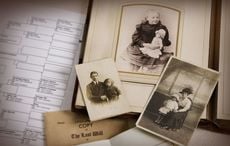On the morning of June 15, 1904, parishioners, mostly women and children, of St. Mark’s Evangelical Church in Manhattan, began boarding The General Slocum, a 264-foot side-wheeler excursion boat, for an all day picnic. Within hours, an event that caused the loss of more than one thousand lives would be part of history; it’s psychic impact incalculable.
As I studied the event my interest was piqued when I came across the name of John J. Coakley, a deck hand, whose actions contributed to the disaster. One of my great great grandfathers was John J. Coakley, an Irish immigrant from County Cork, but he died in New York City in 1903.
I knew, however, that he had a son. Examining a family interment list, I found a John J. Coakley who died on June 16, 1907. Was my great grand uncle John J. Coakley the same man who was on the Slocum that fateful day?
According to newspaper reports, not long after the Slocum left shore Coakley was alerted to smoke coming from a forward cabin. He raced to the room, but mistakenly, he opened its door. Starving for air, the hay burst into flames, the stairs acted as a flue, and the conflagration began. Coakley, who had received no training in fire safety in the eighteen days he’d been aboard, tried to put the fire out with an old canvas. He couldn’t.
Coakley ran up the stairs and found the first mate. They ran down the stairs to view the problem, but the fire was beginning to rage. Precious time had been wasted. Coakley notified the captain, William Van Schaick, of the problem. The captain was navigating the Slocum through Hell Gate, a point in the East River where the waters of the Long Island Sound meet those of the East River, creating one of the most treacherous channels on the eastern seaboard. If the captain had been notified earlier he might have been able to beach the Slocum on Wards Island, which runs along the western portion of Hell Gate.
But it was too late. Amidst the shrieks of mothers and their children gathered at the stern of the boat, seeking refuge from flames fanned by winds, the captain sailed straight ahead to North Brothers Island, three-quarters to one mile away.
By the time Van Schaick beached the boat the carnage was over. Waves of flame had rapidly spread, consuming hundreds. Mangled bodies were found under the paddle wheels. Divers who first went down into the wreck found bodies of women and children piled up in an indescribable horror. Drowning victims floated ashore for days. The death toll, was staggering: 1,021.
Everything that could have gone wrong did. The life preservers on the boat were rotten and mostly useless, the lifeboats were wired to the deck and could not be released, the crew had not been trained in the fire safety, the boat had been freshly painted and was a tinderbox, and fire hoses burst when they were employed.
Was my great-grand-uncle John J. Coakley a deckhand on the Slocum?
I obtained a copy of my great uncle’s death certificate at the Municipal Archives in Manhattan. I learned that Coakley had died of pulmonary tuberculosis in his mother’s home at 246 Clinton Street in Manhattan in 1907 and was employed as a bath attendant at the time of his death.
None of this information served to confirm or deny my great grand uncle’s role in the Slocum disaster. I proceeded to the New York Public Library to view the 1900 Federal Census and found that there were two John J. Coakleys. Neither Coakley had an occupation that was related to the maritime industry. I wasn’t making progress.
Next, I examined New York City Directories from 1900 through 1907. The Directories list the address and occupation of heads of households, widows and boarders. I located both men in the 1904 directory. My great grand uncle was living with his family at 246 Clinton Street. The other John J. Coakley is listed as a painter living on West 31st Street.
I was running out of options until I discovered that author Claude Rust had written a book, The Burning of the General Slocum. I was able to locate Mr. Rust in East Rockaway, New York. I wrote him the following letter:
Dear Mr. Rust,
I have just completed your book, The Burning of the General Slocum. I believe that the John J. Coakley who is listed as a deckhand may be my great grand uncle. My research of the 1900 Federal Census indicates that there were two John J. Coakleys in Manhattan. Both would have been about thirty years of age at the time of the fire.
Perhaps you have material that would help me confirm whether the John J. Coakley on the Slocum was my uncle. Do you have a list of the crew’s addresses before or after the fire?
Any help would be greatly appreciated. I look forward to hearing from you.
Sincerely,
Charles R. Hale.
One week later I received a response from Mr. Rust.
Dear Mr. Hale.
Like the mosquito in the nudist camp, I did not know where to start, then I remembered that I had kept all my research notes, and there he was: John Coakley of 419 West 31st Street. Age 30. Deck hand on the General Slocum.
Sincerely,
Claude Rust
The address indicated that the deckhand John J. Coakley was the painter, not my great-grand-uncle who had lived on Clinton Street.
Now to the point of the story: When I first learned that an ancestor might have been involved in the Slocum tragedy I partly latched onto the story for the wrong reason.
I began looking for a “shadowy character” who might add “color” to my family tree.
And then, one day, as I walked along the East River I imagined the disaster as it sailed yards from where I walked; I remembered the accounts of families whose lives were irretrievably damaged by the disaster, and how Kleindeutschland, the Lower East Side neighborhood where the victims lived, was devastated by the events. I was awakened to the enormity of the event and the frivolity of my search.
Seeking answers locked in the web of my family history, I discovered that certain events eclipse such pursuits.
Have you ever uncovered any surprising stories or chased any red herrings about your ancestors? Share your story in the comment section below.
---
Charles R. Hale was born, raised and educated in New York. He is a former partner of a NYC based consulting firm Hale, Borenstein Ltd. Charles, along with Niamh Hyland, is a cofounder of Artists Without Walls, an organization purposed to inspire, uplift and unite people and communities of diverse cultures through the pursuit of artistic achievement. His film “Walls: We Are Not Forgotten,” about the life of singer Judy Collins, was presented at the 2012 Eugene O’Neill Award ceremony honoring Ms. Collins. In 2013 the City University of New York honored Charles for ”Outstanding Service to New York and Irish America.”




Comments